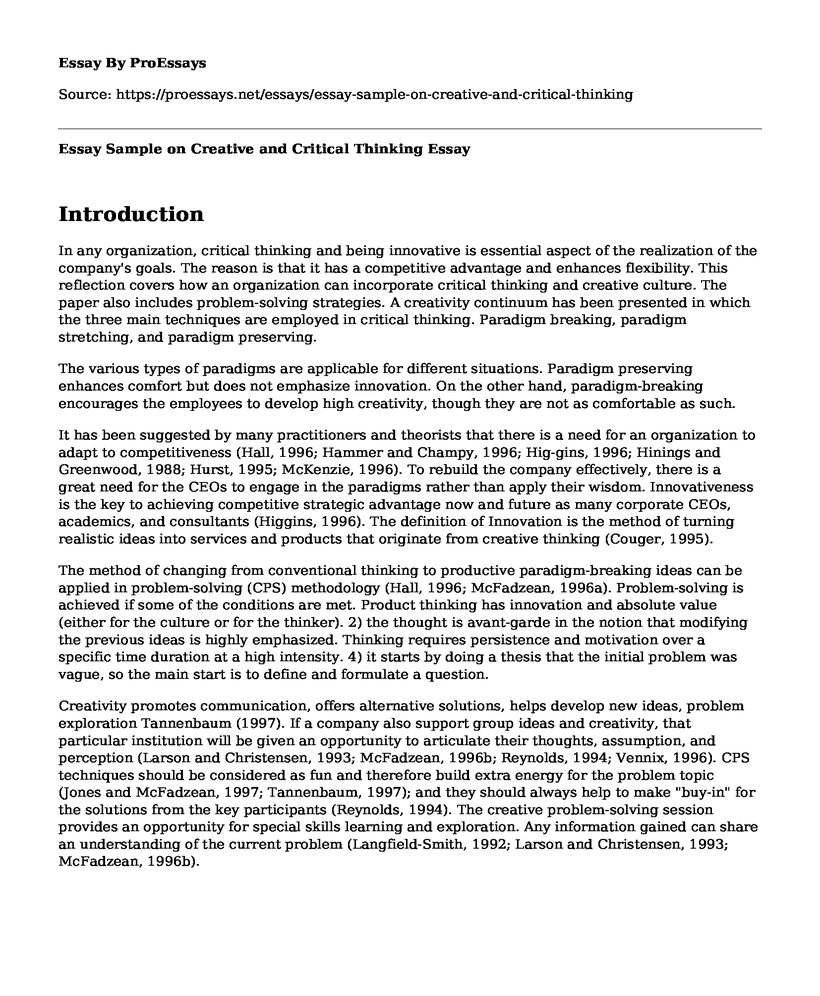Introduction
In any organization, critical thinking and being innovative is essential aspect of the realization of the company's goals. The reason is that it has a competitive advantage and enhances flexibility. This reflection covers how an organization can incorporate critical thinking and creative culture. The paper also includes problem-solving strategies. A creativity continuum has been presented in which the three main techniques are employed in critical thinking. Paradigm breaking, paradigm stretching, and paradigm preserving.
The various types of paradigms are applicable for different situations. Paradigm preserving enhances comfort but does not emphasize innovation. On the other hand, paradigm-breaking encourages the employees to develop high creativity, though they are not as comfortable as such.
It has been suggested by many practitioners and theorists that there is a need for an organization to adapt to competitiveness (Hall, 1996; Hammer and Champy, 1996; Hig-gins, 1996; Hinings and Greenwood, 1988; Hurst, 1995; McKenzie, 1996). To rebuild the company effectively, there is a great need for the CEOs to engage in the paradigms rather than apply their wisdom. Innovativeness is the key to achieving competitive strategic advantage now and future as many corporate CEOs, academics, and consultants (Higgins, 1996). The definition of Innovation is the method of turning realistic ideas into services and products that originate from creative thinking (Couger, 1995).
The method of changing from conventional thinking to productive paradigm-breaking ideas can be applied in problem-solving (CPS) methodology (Hall, 1996; McFadzean, 1996a). Problem-solving is achieved if some of the conditions are met. Product thinking has innovation and absolute value (either for the culture or for the thinker). 2) the thought is avant-garde in the notion that modifying the previous ideas is highly emphasized. Thinking requires persistence and motivation over a specific time duration at a high intensity. 4) it starts by doing a thesis that the initial problem was vague, so the main start is to define and formulate a question.
Creativity promotes communication, offers alternative solutions, helps develop new ideas, problem exploration Tannenbaum (1997). If a company also support group ideas and creativity, that particular institution will be given an opportunity to articulate their thoughts, assumption, and perception (Larson and Christensen, 1993; McFadzean, 1996b; Reynolds, 1994; Vennix, 1996). CPS techniques should be considered as fun and therefore build extra energy for the problem topic (Jones and McFadzean, 1997; Tannenbaum, 1997); and they should always help to make "buy-in" for the solutions from the key participants (Reynolds, 1994). The creative problem-solving session provides an opportunity for special skills learning and exploration. Any information gained can share an understanding of the current problem (Langfield-Smith, 1992; Larson and Christensen, 1993; McFadzean, 1996b).
Conclusion
Creativity in an organization has a significant contribution to the creation of tangible benefits. A good example is in the case of money returns in a company. A company giving room for creativity and critical thinking always promotes the creation of extra income because the employees are vibrant towards bringing out new innovative ideas. Avoiding criticism and punishment can result in reduced project success, to avoid demoralizing the employees, they should be motivated and encouraged. Motivating an individual when a particular project fails, helps them build courage and try to attempt new ideas which may be helpful. The organization employees should be encouraged to challenge their perception and procedures towards processes, services, products, and systems. (Jones and McFadzean, 1997).
References
McFadzean, E. (2000). What can we learn from creative people? The story of Brian Eno. Management Decision, 38(1), 51-56.
Anderson, N., Hardy, G. and West, M. (1992), "Management team innovation," Management Decision, Vol. 30, No. 2, pp. 17-21.
Belbin, R. M. (2010). Management teams. Routledge.
Briggs, R. O., & Nunamaker, J. F. (1996). Team theory of group productivity and its application to development and testing of group support systems. Unpublished manuscript.
Checkland, P., & Scholes, J. (1990). Soft Systems Methodology in Action Chichester.
Couger, J. D. (1995). Creative problem solving and opportunity finding. Boyd & Fraser publishing company.
Cite this page
Essay Sample on Creative and Critical Thinking. (2022, Mar 10). Retrieved from https://proessays.net/essays/essay-sample-on-creative-and-critical-thinking
If you are the original author of this essay and no longer wish to have it published on the ProEssays website, please click below to request its removal:
- My Interest in Medicine Essay
- Teaching Methods Essay Example
- Essay on Children Fairy Tales
- Paper Example on Gentrification & Its Impact on US Neighborhoods
- Paper Example on Celebrating Milly Ambrose: A Tribute to a Beloved Grandmother
- Community Service Work Experience Paper Example
- Paper Sample on Leadership Style Impact on School Performance & Rapid Improvement







